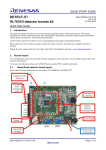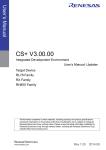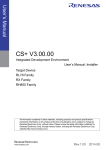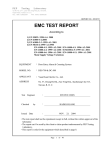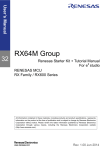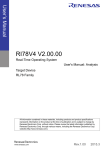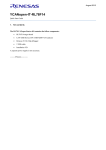Download RL78/G14 Recommended PCB Layout for Reducing Noise
Transcript
APPLICATION NOTE RL78/G14 Recommended PCB Layout for Reducing Noise R01AN1876EC0100 Rev. 1.00 Feb. 28, 2014 Introduction The purpose of this document is to help the user understand how to design a good PCB layout with high reducing noise performance. A thorough system evaluation is necessary after taking the countermeasures mentioned in this document. This document provides an explanation using RL78/G14 sample boards. Target Device RL78/G14 The test results are applied to the following conditions: • MCU: • PCB type: RL78/G14 64-pin Single-side printed board without a polygon R01AN1876EC0100 Rev. 1.00 Feb. 28, 2014 Page 1 of 14 RL78/G14 Recommended PCB Layout for Reducing Noise Contents 1. Preface .............................................................................................................................. 3 2. Recommended PCB Layout ............................................................................................ 4 2.1 Wiring of VDD and VSS .............................................................................................................. 4 2.2 Oscillator Concerns .................................................................................................................... 4 2.3 Bypass Capacitor........................................................................................................................ 4 2.4 Wiring of RESET Pin ................................................................................................................... 4 2.5 Wiring of REGC Pin..................................................................................................................... 4 2.6 Wiring of TOOL0 Pin ................................................................................................................... 4 3. Description of the Test Board......................................................................................... 5 3.1 Schematics of the Test Board ................................................................................................... 5 3.2 PCB Layout of the Two Test Boards......................................................................................... 5 3.3 Differences between Recommended Layout and Non-recommended Layout ..................... 6 3.3.1 Wiring of VDD and VSS .......................................................................................................... 6 3.3.2 Oscillator Concerns................................................................................................................. 6 3.3.3 Bypass Capacitor.................................................................................................................... 6 3.3.4 Wiring of RESET Pin............................................................................................................... 7 3.3.5 Wiring of REGC Pin ................................................................................................................ 7 3.3.6 Wiring of TOOL0 Pin............................................................................................................... 7 3.4 4. Block Diagram of the Test Board .............................................................................................. 7 Reducing Noise Test of Different Layout....................................................................... 9 4.1 Test Description .......................................................................................................................... 9 4.2 Test Conditions ........................................................................................................................... 9 4.3 Test Results............................................................................................................................... 10 4.4 Test Conclusions ...................................................................................................................... 11 5. Improve the Non-recommended Board........................................................................ 12 5.1 Modification of the Non-recommended Board....................................................................... 12 5.2 Test Results of the Modified Board......................................................................................... 13 5.3 Recommendations for PCB Board Improvement .................................................................. 13 6. Documents for Reference ............................................................................................. 14 R01AN1876EC0100 Rev. 1.00 Feb. 28, 2014 Page 2 of 14 RL78/G14 1. Recommended PCB Layout for Reducing Noise Preface This application note describes how to design PCB layout to achieve high reducing noise performance. The countermeasures of recommended PCB layout are shown in this application note. And the AC line noise contrast test with two types of PCB layout boards is introduced to verify these countermeasures. Subsequently, the improvement test which is based on the non-recommended board is also introduced in this application note. R01AN1876EC0100 Rev. 1.00 Feb. 28, 2014 Page 3 of 14 RL78/G14 2. Recommended PCB Layout for Reducing Noise Recommended PCB Layout Good PCB layout is very important in reducing noise design. Some countermeasures of improving reducing noise performance are shown below. 2.1 • • • • Wiring of VDD and VSS Connect the MCU and main power supply with the shortest possible wiring. Make the VDD and VSS wiring equal in length. Make the wiring for the VDD and VSS wider than other signal wiring. Separate the wiring for the VDD and VSS on the MCU from the wiring for the peripheral function power supply. And try to separate them at the entrance of the main power supply. 2.2 Oscillator Concerns • Place the oscillator circuit close to the MCU. • Connect the MCU and oscillator circuit with the shortest possible wiring. • Separate the VSS wiring between the MCU and the oscillator from the VSS wiring for the other peripherals. 2.3 Bypass Capacitor • Place the bypass capacitor between VSS wiring and VDD wiring close to the MCU. And make power supply wiring connect to the MCU via the bypass capacitor leads. • Make the wiring length between the bypass capacitor and VDD pin or VSS pin equal and as short as possible. 2.4 Wiring of RESET Pin • Place the reset circuit close to the MCU. • Connect the MCU and reset circuit with the shortest possible wiring. • Separate the VDD wiring and VSS wiring of reset circuit from the VSS and VDD wiring for the other peripherals. 2.5 Wiring of REGC Pin • Connect the REGC pin to VSS via a 0.47 to 1 μF (default: 0.47 μF) capacitor as the MCU user’s manual recommends. • Place the REGC circuit close to the MCU. • Connect the MCU and REGC circuit with the shortest possible wiring. 2.6 Wiring of TOOL0 Pin • Connect the TOOL0 pin to VDD via a 1 kΩ resistor as the MCU user’s manual recommends. • Place the TOOL0 circuit close to the MCU. • Connect the MCU and TOOL0 circuit with the shortest possible wiring. R01AN1876EC0100 Rev. 1.00 Feb. 28, 2014 Page 4 of 14 RL78/G14 3. Recommended PCB Layout for Reducing Noise Description of the Test Board This section shows examples of the recommended layout and non-recommended layout. Both the recommended board and non-recommended board are made with the same schematics and components. Only the PCB layouts are different. With the recommended methods, the recommended PCB board can achieve higher reducing noise performance. 3.1 Schematics of the Test Board The recommended layout and the non-recommended one are designed with the same schematics. Figure 3.1 shows the schematics of the circuits around the MCU. Figure 3.1 3.2 Schematics of the Circuits around the MCU PCB Layout of the Two Test Boards This section shows examples of the recommended layout and non-recommended layout. The PCB layout should be designed in accordance with recommended one to achieve higher reducing noise performance. The reasons why the PCB layout on the left in Figure 3.2 is recommended are explained in next section. Figure 3.2 shows the PCB layout around the MCU of two test boards. R01AN1876EC0100 Rev. 1.00 Feb. 28, 2014 Page 5 of 14 RL78/G14 Figure 3.2 3.3 Recommended PCB Layout for Reducing Noise Recommended Layout (Left) and Non-recommended Layout (Right) Differences between Recommended Layout and Non-recommended Layout This section introduces the main differences between the recommended layout and the non-recommended layout. 3.3.1 Wiring of VDD and VSS The VDD and VSS wiring of the recommended board are separated from peripheral power supply wiring at the entrance of the main power supply. And the VDD wiring and VSS wiring of the recommended board are closer to each other than the non-recommended board. Especially on the non-recommended board, the VDD wiring of the MCU is connected to main power supply through jumper J1 before filter capacitor C9. Reason: It is better to separate the MCU power supply wiring and peripheral power supply wiring. In this way, it can avoid the noise into the MCU through peripherals. The MCU power supply wiring should be connected to main power supply after connecting to filter capacitors. Otherwise, the filter capacitors will not work effectively. 3.3.2 Oscillator Concerns Oscillator circuits X1, C1, and C2 on the recommended board are closer to the MCU than the non-recommended one. The wiring from oscillator circuit to the MCU on the recommended board is shorter than the non-recommended one. On the non-recommended board, the oscillator circuit is not at the terminal of VSS wiring and not separated from other VSS wiring. Reason: Long wiring may have an antenna effect to catch noise. If noise enters the clock pins, clock waveform may be deformed. This may cause program failure or runaway. Also if the potential difference is caused by the noise between the oscillator VSS level and the MCU VSS level, the correct clock will not be input to the MCU. 3.3.3 Bypass Capacitor Bypass capacitor C4 on the recommend board is closer to the MCU than the non-recommended one. And the wiring from the bypass capacitor to the MCU is shorter than the non-recommended one. Especially on the non-recommended board, the leads of C4 are not directly connected to the VDD and VSS trunk wiring. Reason: Longer wiring will generate larger impedance for noise signal. Longer wiring may resist the noise current through the noise return circuit. Also long wiring between the bypass capacitor and the MCU may become a noise antenna. R01AN1876EC0100 Rev. 1.00 Feb. 28, 2014 Page 6 of 14 RL78/G14 3.3.4 Recommended PCB Layout for Reducing Noise Wiring of RESET Pin Reset circuits R1, D1, and C6 on the recommend board are closer to the MCU than the non-recommended one. And the wiring from the reset circuit to the MCU is shorter than the non-recommended one. On the non-recommended board, the leads of R1, D1, and C6 are not directly connected to the MCU VDD and VSS wiring, but connected to the main power supply VDD and VSS wiring. Reason: The reset signal initializes the internal MCU state. If fine noise-like pulses pass through the reset signal wiring, the MCU may not completely initialize (partially initialize). It is better to shorten the wiring of the reset circuit to reduce the noise effect. 3.3.5 Wiring of REGC Pin The REGC circuit C3 on the recommend board is closer to the MCU than the non-recommended one. And the wiring from the REGC circuit to the MCU is shorter than the non-recommended one. On the non-recommended board, the VSS of C3 is connected to VSS lines before the MCU bypass capacitor C4. Reason: The long wiring between C3 and the MCU REGC pin may become a noise antenna. The REGC should be connected to VSS wiring after the bypass capacitor, otherwise the bypass capacitor effect will be weakened. 3.3.6 Wiring of TOOL0 Pin The TOOL0 circuit R2 on the recommend board is closer to the MCU than the non-recommended one. And the wiring from the TOOL0 circuit to the MCU is shorter than the non-recommended one. On the non-recommended board, the VDD of R2 is not connected to the MCU VDD, but connected to the main power VDD wiring. Reason: The long wiring between R2 and the MCU TOOL0 pin may become a noise antenna. If the potential difference is caused by noise between TOOL0 VDD and MCU VDD level, it may affect the MCU working status. 3.4 Block Diagram of the Test Board The test board will perform some sample functions under noise test. The MCU operation status can be shown by the two groups of LEDs (Red and Yellow). After the MCU resets, all LEDs will blink for 5 seconds. Then the two groups of LEDs will light from “00002” to “11112” by “12”. One group is controlled by the main loop; the other group is controlled by timer interrupt routine. These two groups of LEDs will blink synchronously. Figure 3.3 shows the block diagram of the test board. R01AN1876EC0100 Rev. 1.00 Feb. 28, 2014 Page 7 of 14 RL78/G14 Recommended PCB Layout for Reducing Noise Reset System initialization Interrupt handler Interrupt initialization All LEDs ON for 5 sec. 0.5 sec. change All LEDs OFF Illuminated LEDs ...... Illuminated LEDs RTI 0.5 sec. change ...... LED OFF LED ON Note: The red LEDs are controlled by the main loop and the yellow LEDs are controlled by the interrupt handler. The red and yellow LEDs blink synchronously. Figure 3.3 R01AN1876EC0100 Rev. 1.00 Feb. 28, 2014 Block Diagram of the Test Board Page 8 of 14 RL78/G14 4. 4.1 Recommended PCB Layout for Reducing Noise Reducing Noise Test of Different Layout Test Description In this test, two types of PCB were used. One is designed according to the countermeasures. The other is designed without the countermeasures. The PCB layouts around the MCU are shown as Figure 3.2. The peripheral circuits on the two boards are same. Same noise interference is input to the two test boards through the power supply for 1 minute. The peak value of noise interference steps up in 100 V increments from 100 V to 4000 V in every test. On the target boards, there are two groups of LEDs that blink to show the MCU status. All LEDs will be ON for 5 seconds after the MCU resets. Then the two groups of LEDs will blink from “00002” to “11112” by “12”. One group is controlled by the main loop; the other group is controlled by timer interrupt. These two groups of LEDs will blink synchronously. The MCU status can be evaluated by observing these LEDs. • If the MCU operates normally within 1 minute, the result is considered good and the table is filled with a “ ”. • If the MCU generates an abnormal phenomena (reset, program runaway, or LEDs blink asynchronously) within 1 minute, the result is considered not good and the table is filled with a “ ”. Figure 4.1 shows the diagram of test environment. 1:1 AC220V Power supply for test circuit Isolated transformer AC220V AC220V Power supply for noise generator Figure 4.1 4.2 LEDs Noise Generator Output Power input Source input Power AC220V + Noise circuit MCU DC5V Diagram of Test Environment Test Conditions • Test tools: ⎯ Noise generator: NoiseKen INS-4040 ⎯ Target board: Recommended board and non-recommended board • Test conditions: ⎯ Target board power: 220 V 50 Hz ⎯ MCU type: R5F104LEAFA ⎯ Oscillation frequency: 20 MHz ⎯ MCU power source: 5 V ⎯ MCU bypass capacitor: 0.1 μF ⎯ Noise period: 16 ms ⎯ Noise pulse width: 50 ns ⎯ Noise polarity: plus and minus ⎯ Noise peak value: 100 to 4000 V ⎯ Test time: 1 minute R01AN1876EC0100 Rev. 1.00 Feb. 28, 2014 Page 9 of 14 RL78/G14 4.3 Recommended PCB Layout for Reducing Noise Test Results Table 4.1 Test Results of Recommended Board and Non-recommended Board Layout Recommended Board Test Results Polarity Non-recommended Board Test Results + − + Voltage 4000 (2) 3900 (2) 3800 (2) 3700 (3) 3600 (3) 3500 (3) 3400 (3) 3300 (3) 3200 (3) 3100 (3) 3000 (3) 2900 (3) 2800 (3) 2700 (3) 2600 (3) 2500 (3) 2400 (3) 2300 (3) 2200 2100 2000 Note: Voltage: Noise value (Unit: V, higher value shows higher reducing noise capability) Polarity: Noise polarity added to target board power source : Normal MCU operation (1): Reset cannot be released; (2): Reset → Rerun → Reset; (3): Main loop error or runaway R01AN1876EC0100 Rev. 1.00 Feb. 28, 2014 − (3) (3) (3) (3) (3) (3) (3) (3) (3) (3) (3) (3) (3) (3) (3) (3) Page 10 of 14 RL78/G14 4.4 Recommended PCB Layout for Reducing Noise Test Conclusions The test results only show the reducing noise performance of the tested boards. As is shown in Table 4.1, the result of noise interference test on the recommended board is about 4000 V (the maxim value of test condition), and the non-recommended one is below 2500 V. Conclusions from this test are as follows: • Higher reducing noise performance can be achieved by designing a PCB layout according to the recommendations. • Due to the high reducing noise performance of the MCU, the worst phenomenon (reset can not be released) did not occur even in the non-recommended board noise test. Note: Keep the MCU away from high voltage noise, even if it is designed with the recommended PCB layout. The test results are available only to distinguish the noise effects on different layouts and do not represent the MCU performance. R01AN1876EC0100 Rev. 1.00 Feb. 28, 2014 Page 11 of 14 RL78/G14 5. Recommended PCB Layout for Reducing Noise Improve the Non-recommended Board After the above test, modifications were made on the non-recommended board and retested under the same conditions. In this test, the non-recommended PCB board was modified provisionally to improve reducing noise performance. When developing a product, the PCB layout should be redesigned according to the recommended layout for high performance. 5.1 Modification of the Non-recommended Board Modified items are listed below: • VDD and VSS: Remove J1 and connect the MCU VDD to C9 with a jumper line to modify the VDD wiring connection. Cutoff the VSS wiring of oscillator circuit and reset circuit to modify the VSS connection. Refer to the red section in Figure 5.1. • Oscillator concerns: Cutoff the original wiring which connects the VSS of oscillator circuit to the MCU VSS pin. Connect them with a jumper to shorten the VSS wiring of the oscillator circuit. Refer to the orange section in the Figure 5.1. • Bypass capacitor: Move C4 close to the MCU. Refer to the violet section in the Figure 5.1. • Reset circuit: Cutoff the original wiring of reset circuit which connects to the VDD and VSS. Connect these components (R1, D1, C6) to the MCU VDD and VSS with jumper lines. Refer to the blue section in the Figure 5.1. • REGC circuit: Move C3 close to the MCU. Refer to the gold section in the Figure 5.1. • TOOL0 circuit: Move R2 close to the MCU. Refer to the green section in the Figure 5.1. Figure 5.1 R01AN1876EC0100 Rev. 1.00 Feb. 28, 2014 Improving the Non-recommended Board Page 12 of 14 RL78/G14 5.2 Recommended PCB Layout for Reducing Noise Test Results of the Modified Board Table 5.1 Test Results of Non-recommended Board Improvement Non-recommended Layout Polarity After Modification Before Modification + − + − Voltage 4000 (2) (3) 3900 (2) (3) 3800 (2) (3) 3700 (3) (3) 3600 (3) (3) 3500 (3) (3) 3400 (3) (3) 3300 (3) (3) 3200 (3) (3) 3100 (3) (3) 3000 (3) (3) 2900 (3) (3) 2800 (3) (3) 2700 (3) (3) 2600 (3) (3) 2500 (3) (3) 2400 (3) 2300 (3) 2200 2100 2000 Note: Voltage: Noise Value (Unit: V, Higher value shows higher reducing noise capability) Polarity: Noise polarity added to target board power source : Normal MCU operation (1): Reset can not be released; (2): Reset → Rerun → Reset; (3): Main loop error or runaway 5.3 Recommendations for PCB Board Improvement After modifications are made on the non-recommended board, the results of reducing noise performance improved drastically. But when developing a product, the PCB should be redesigned according to the recommended layout. Note the following precautions for designing the PCB layout. • VDD and VSS: Separate the MCU VDD and VSS wiring from peripherals’ VDD and VSS wiring. Connect to the main power supply after the filter capacitors. • Oscillator concerns: Use the shortest possible wiring to connect the oscillator, capacitor and MCU. Separate oscillator’s VSS from other peripherals’ VSS wiring. • Bypass capacitor: Place the bypass capacitor as close to the MCU as possible. Make sure the leads of the bypass capacitor are set on the VDD and VSS trunk wiring. • Reset circuit: Use the shortest wiring pattern to connect resistor, capacitor and diode. • REGC and TOOL0: Place the capacitor and resistor as close to the MCU as possible. R01AN1876EC0100 Rev. 1.00 Feb. 28, 2014 Page 13 of 14 RL78/G14 6. Recommended PCB Layout for Reducing Noise Documents for Reference User’s Manual: RL78/G14 User's Manual: Hardware (R01UH0186EJ) RL78 Family User's Manual: Software (R01US0015EJ) The latest versions can be downloaded from the Renesas Electronics website. Technical Updates/Technical News The latest information can be downloaded from the Renesas Electronics website. Website and Support Renesas Electronics Website http://www.renesas.com/index.jsp Inquiries http://www.renesas.com/contact/ All trademarks and registered trademarks are the property of their respective owners. R01AN1876EC0100 Rev. 1.00 Feb. 28, 2014 Page 14 of 14 Revision History Rev. 1.00 Date Feb. 28, 2014 Description Page Summary — First edition issued A-1 General Precautions in the Handling of MPU/MCU Products The following usage notes are applicable to all MPU/MCU products from Renesas. For detailed usage notes on the products covered by this document, refer to the relevant sections of the document as well as any technical updates that have been issued for the products. 1. Handling of Unused Pins Handle unused pins in accordance with the directions given under Handling of Unused Pins in the manual. ⎯ The input pins of CMOS products are generally in the high-impedance state. In operation with an unused pin in the open-circuit state, extra electromagnetic noise is induced in the vicinity of LSI, an associated shoot-through current flows internally, and malfunctions occur due to the false recognition of the pin state as an input signal become possible. Unused pins should be handled as described under Handling of Unused Pins in the manual. 2. Processing at Power-on The state of the product is undefined at the moment when power is supplied. ⎯ The states of internal circuits in the LSI are indeterminate and the states of register settings and pins are undefined at the moment when power is supplied. In a finished product where the reset signal is applied to the external reset pin, the states of pins are not guaranteed from the moment when power is supplied until the reset process is completed. In a similar way, the states of pins in a product that is reset by an on-chip power-on reset function are not guaranteed from the moment when power is supplied until the power reaches the level at which resetting has been specified. 3. Prohibition of Access to Reserved Addresses Access to reserved addresses is prohibited. ⎯ The reserved addresses are provided for the possible future expansion of functions. Do not access these addresses; the correct operation of LSI is not guaranteed if they are accessed. 4. Clock Signals After applying a reset, only release the reset line after the operating clock signal has become stable. When switching the clock signal during program execution, wait until the target clock signal has stabilized. ⎯ When the clock signal is generated with an external resonator (or from an external oscillator) during a reset, ensure that the reset line is only released after full stabilization of the clock signal. Moreover, when switching to a clock signal produced with an external resonator (or by an external oscillator) while program execution is in progress, wait until the target clock signal is stable. 5. Differences between Products Before changing from one product to another, i.e. to a product with a different part number, confirm that the change will not lead to problems. ⎯ The characteristics of an MPU or MCU in the same group but having a different part number may differ in terms of the internal memory capacity, layout pattern, and other factors, which can affect the ranges of electrical characteristics, such as characteristic values, operating margins, immunity to noise, and amount of radiated noise. When changing to a product with a different part number, implement a system-evaluation test for the given product. Notice 1. Descriptions of circuits, software and other related information in this document are provided only to illustrate the operation of semiconductor products and application examples. You are fully responsible for the incorporation of these circuits, software, and information in the design of your equipment. Renesas Electronics assumes no responsibility for any losses incurred by you or third parties arising from the use of these circuits, software, or information. 2. Renesas Electronics has used reasonable care in preparing the information included in this document, but Renesas Electronics does not warrant that such information is error free. Renesas Electronics assumes no liability whatsoever for any damages incurred by you resulting from errors in or omissions from the information included herein. 3. Renesas Electronics does not assume any liability for infringement of patents, copyrights, or other intellectual property rights of third parties by or arising from the use of Renesas Electronics products or technical information described in this document. No license, express, implied or otherwise, is granted hereby under any patents, copyrights or other intellectual property rights of Renesas Electronics or others. 4. You should not alter, modify, copy, or otherwise misappropriate any Renesas Electronics product, whether in whole or in part. Renesas Electronics assumes no responsibility for any losses incurred by you or third parties arising from such alteration, modification, copy or otherwise misappropriation of Renesas Electronics product. 5. Renesas Electronics products are classified according to the following two quality grades: "Standard" and "High Quality". The recommended applications for each Renesas Electronics product depends on the product's quality grade, as indicated below. "Standard": Computers; office equipment; communications equipment; test and measurement equipment; audio and visual equipment; home electronic appliances; machine tools; personal electronic equipment; and industrial robots etc. "High Quality": Transportation equipment (automobiles, trains, ships, etc.); traffic control systems; anti-disaster systems; anti-crime systems; and safety equipment etc. Renesas Electronics products are neither intended nor authorized for use in products or systems that may pose a direct threat to human life or bodily injury (artificial life support devices or systems, surgical implantations etc.), or may cause serious property damages (nuclear reactor control systems, military equipment etc.). You must check the quality grade of each Renesas Electronics product before using it in a particular application. You may not use any Renesas Electronics product for any application for which it is not intended. Renesas Electronics shall not be in any way liable for any damages or losses incurred by you or third parties arising from the use of any Renesas Electronics product for which the product is not intended by Renesas Electronics. 6. You should use the Renesas Electronics products described in this document within the range specified by Renesas Electronics, especially with respect to the maximum rating, operating supply voltage range, movement power voltage range, heat radiation characteristics, installation and other product characteristics. Renesas Electronics shall have no liability for malfunctions or damages arising out of the use of Renesas Electronics products beyond such specified ranges. 7. Although Renesas Electronics endeavors to improve the quality and reliability of its products, semiconductor products have specific characteristics such as the occurrence of failure at a certain rate and malfunctions under certain use conditions. Further, Renesas Electronics products are not subject to radiation resistance design. Please be sure to implement safety measures to guard them against the possibility of physical injury, and injury or damage caused by fire in the event of the failure of a Renesas Electronics product, such as safety design for hardware and software including but not limited to redundancy, fire control and malfunction prevention, appropriate treatment for aging degradation or any other appropriate measures. Because the evaluation of microcomputer software alone is very difficult, please evaluate the safety of the final products or systems manufactured by you. 8. Please contact a Renesas Electronics sales office for details as to environmental matters such as the environmental compatibility of each Renesas Electronics product. Please use Renesas Electronics products in compliance with all applicable laws and regulations that regulate the inclusion or use of controlled substances, including without limitation, the EU RoHS Directive. Renesas Electronics assumes no liability for damages or losses occurring as a result of your noncompliance with applicable laws and regulations. 9. Renesas Electronics products and technology may not be used for or incorporated into any products or systems whose manufacture, use, or sale is prohibited under any applicable domestic or foreign laws or regulations. You should not use Renesas Electronics products or technology described in this document for any purpose relating to military applications or use by the military, including but not limited to the development of weapons of mass destruction. When exporting the Renesas Electronics products or technology described in this document, you should comply with the applicable export control laws and regulations and follow the procedures required by such laws and regulations. 10. It is the responsibility of the buyer or distributor of Renesas Electronics products, who distributes, disposes of, or otherwise places the product with a third party, to notify such third party in advance of the contents and conditions set forth in this document, Renesas Electronics assumes no responsibility for any losses incurred by you or third parties as a result of unauthorized use of Renesas Electronics products. 11. This document may not be reproduced or duplicated in any form, in whole or in part, without prior written consent of Renesas Electronics. 12. Please contact a Renesas Electronics sales office if you have any questions regarding the information contained in this document or Renesas Electronics products, or if you have any other inquiries. (Note 1) "Renesas Electronics" as used in this document means Renesas Electronics Corporation and also includes its majority-owned subsidiaries. (Note 2) "Renesas Electronics product(s)" means any product developed or manufactured by or for Renesas Electronics. SALES OFFICES http://www.renesas.com Refer to "http://www.renesas.com/" for the latest and detailed information. Renesas Electronics America Inc. 2880 Scott Boulevard Santa Clara, CA 95050-2554, U.S.A. Tel: +1-408-588-6000, Fax: +1-408-588-6130 Renesas Electronics Canada Limited 1101 Nicholson Road, Newmarket, Ontario L3Y 9C3, Canada Tel: +1-905-898-5441, Fax: +1-905-898-3220 Renesas Electronics Europe Limited Dukes Meadow, Millboard Road, Bourne End, Buckinghamshire, SL8 5FH, U.K Tel: +44-1628-651-700, Fax: +44-1628-651-804 Renesas Electronics Europe GmbH Arcadiastrasse 10, 40472 Düsseldorf, Germany Tel: +49-211-65030, Fax: +49-211-6503-1327 Renesas Electronics (China) Co., Ltd. 7th Floor, Quantum Plaza, No.27 ZhiChunLu Haidian District, Beijing 100083, P.R.China Tel: +86-10-8235-1155, Fax: +86-10-8235-7679 Renesas Electronics (Shanghai) Co., Ltd. Unit 301, Tower A, Central Towers, 555 LanGao Rd., Putuo District, Shanghai, China Tel: +86-21-2226-0888, Fax: +86-21-2226-0999 Renesas Electronics Hong Kong Limited Unit 1601-1613, 16/F., Tower 2, Grand Century Place, 193 Prince Edward Road West, Mongkok, Kowloon, Hong Kong Tel: +852-2886-9318, Fax: +852 2886-9022/9044 Renesas Electronics Taiwan Co., Ltd. 13F, No. 363, Fu Shing North Road, Taipei, Taiwan Tel: +886-2-8175-9600, Fax: +886 2-8175-9670 Renesas Electronics Singapore Pte. Ltd. 80 Bendemeer Road, Unit #06-02 Hyflux Innovation Centre Singapore 339949 Tel: +65-6213-0200, Fax: +65-6213-0300 Renesas Electronics Malaysia Sdn.Bhd. Unit 906, Block B, Menara Amcorp, Amcorp Trade Centre, No. 18, Jln Persiaran Barat, 46050 Petaling Jaya, Selangor Darul Ehsan, Malaysia Tel: +60-3-7955-9390, Fax: +60-3-7955-9510 Renesas Electronics Korea Co., Ltd. 12F., 234 Teheran-ro, Gangnam-Gu, Seoul, 135-080, Korea Tel: +82-2-558-3737, Fax: +82-2-558-5141 © 2014 Renesas Electronics Corporation. All rights reserved. Colophon 3.0

















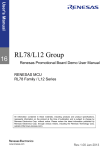
![[e 2 studio] Renesas Starter Kit for RL78/G14 User`s Manual](http://vs1.manualzilla.com/store/data/005759786_1-25eb95ad780cf22f415f84b4d3ed0c87-150x150.png)
